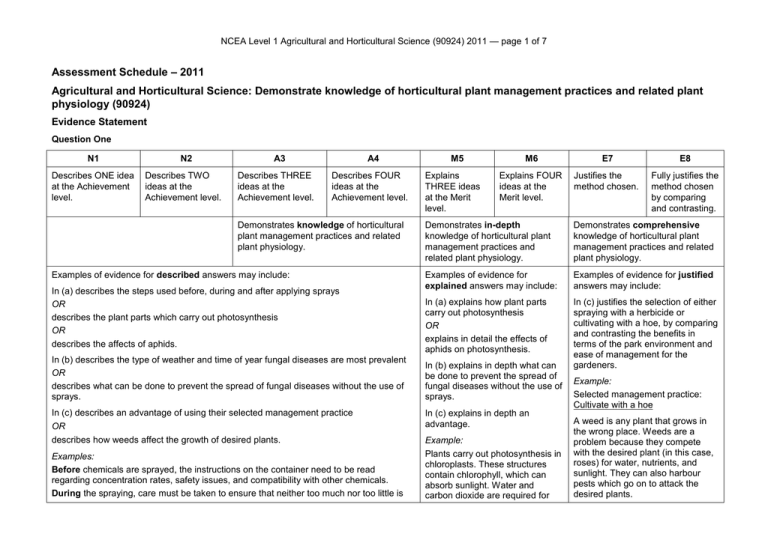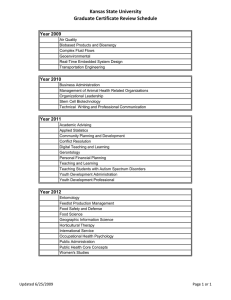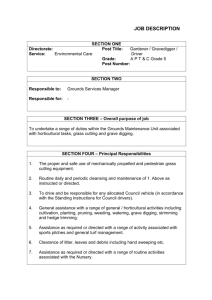– 2011 Assessment Schedule
advertisement

NCEA Level 1 Agricultural and Horticultural Science (90924) 2011 — page 1 of 7 Assessment Schedule – 2011 Agricultural and Horticultural Science: Demonstrate knowledge of horticultural plant management practices and related plant physiology (90924) Evidence Statement Question One N1 Describes ONE idea at the Achievement level. N2 Describes TWO ideas at the Achievement level. A3 Describes THREE ideas at the Achievement level. A4 Describes FOUR ideas at the Achievement level. Demonstrates knowledge of horticultural plant management practices and related plant physiology. Examples of evidence for described answers may include: In (a) describes the steps used before, during and after applying sprays OR describes the plant parts which carry out photosynthesis OR describes the affects of aphids. M5 Explains THREE ideas at the Merit level. M6 E7 E8 Explains FOUR ideas at the Merit level. Justifies the method chosen. Fully justifies the method chosen by comparing and contrasting. Demonstrates in-depth knowledge of horticultural plant management practices and related plant physiology. Demonstrates comprehensive knowledge of horticultural plant management practices and related plant physiology. Examples of evidence for explained answers may include: Examples of evidence for justified answers may include: In (a) explains how plant parts carry out photosynthesis OR explains in detail the effects of aphids on photosynthesis. In (c) justifies the selection of either spraying with a herbicide or cultivating with a hoe, by comparing and contrasting the benefits in terms of the park environment and ease of management for the gardeners. In (b) describes the type of weather and time of year fungal diseases are most prevalent OR describes what can be done to prevent the spread of fungal diseases without the use of sprays. In (b) explains in depth what can be done to prevent the spread of fungal diseases without the use of sprays. In (c) describes an advantage of using their selected management practice OR In (c) explains in depth an advantage. describes how weeds affect the growth of desired plants. Example: Plants carry out photosynthesis in chloroplasts. These structures contain chlorophyll, which can absorb sunlight. Water and carbon dioxide are required for Examples: Before chemicals are sprayed, the instructions on the container need to be read regarding concentration rates, safety issues, and compatibility with other chemicals. During the spraying, care must be taken to ensure that neither too much nor too little is Example: Selected management practice: Cultivate with a hoe A weed is any plant that grows in the wrong place. Weeds are a problem because they compete with the desired plant (in this case, roses) for water, nutrients, and sunlight. They can also harbour pests which go on to attack the desired plants. NCEA Level 1 Agricultural and Horticultural Science (90924) 2011 — page 2 of 7 applied. Afterwards, the spray pack should be cleaned in an appropriate area, with excess spray disposed of safely. Plants carry out photosynthesis in leaves (chloroplasts). When aphids suck the sap from roses, the growth of plants is reduced because new leaves are damaged. Fungal diseases flourish most during warm, humid (wet and warm), weather such as during spring and autumn. The spread of black spot can be prevented by removing leaves that show signs of infection, but not the whole plant. Using a garden hoe is cheap and efficient. Weeds compete for nutrients and space, and provide a place for pests to hide. NØ = No response; no relevant evidence. photosynthesis to occur, which produces glucose sugar and oxygen gas. When aphids suck the sap from roses, the growth of plants is reduced because new leaves are damaged or eaten. Without more leaves, the plant cannot carry out photosynthesis effectively. Fungal diseases flourish most during warm, humid weather. Spring and autumn tend to be the times of year which are warm with rain, and this allows fungal diseases such as black spot to attack roses. The spread of black spot can be prevented by removing leaves that show signs of infection. Keeping a clean, weed-free garden reduces the material on which the disease could be harboured. Choose rose plants that are resistant to the disease. Whilst it might be considered that spraying with herbicide is physically less challenging than cultivating because the roses are in a public park, the health and safety of users of the park must be considered. Another reason for the use of hoes is that it allows the gardeners to check the overall health of the roses as they work around them. It also aerates the soil. This type of weeding will require the gardeners to be more active around the rose garden, but not excessively so, as they would need to repeatedly spray the weeds anyway. This is because they could not use a longterm, non-selective herbicide, as this could damage the roses. One reason for the use of hoes is that it allows the gardeners to check the overall health of the roses as they work around them. E8 – Comparison of two techniques. Plant physiology must be referred to in the answer, or the intent of the standard is not followed. E7 – Clear justification for chosen technique. NCEA Level 1 Agricultural and Horticultural Science (90924) 2011 — page 3 of 7 Question Two N1 Describes ONE idea at the Achievement level. N2 Describes TWO ideas at the Achievement level. A3 Describes THREE ideas at the Achievement level. A4 Describes FOUR ideas at the Achievement level. Demonstrates knowledge of horticultural plant management practices and related plant physiology. Examples of evidence for described answers may include: In (a) describes the steps used to prune small rose stems OR draws clearly labelled supporting diagrams. In (b) describes how plants grow after pruning OR the affect of seasonal conditions on pruned plants. Examples: Identify which branches should be cut to give the right shape Use sharp secateurs. Remove pruned-off material. Cut stem off just above an outward-facing bud and on an angle away from the bud so that it grows outwards. Pruning in late winter, just before the plants start to produce new growth, prevents frost damage. M5 Explains THREE ideas at the Merit level. M6 E7 E8 Explains FOUR ideas at the Merit level. Justifies the method chosen. Fully justifies the method chosen by comparing and contrasting. Demonstrates in-depth knowledge of horticultural plant management practices and related plant physiology. Demonstrates comprehensive knowledge of horticultural plant management practices and related plant physiology. Examples of evidence for explained answers may include: In (a) explains in depth why the steps used to prune small rose stems are necessary for healthy plant growth. In (b) explains in depth how plants grow after pruning OR Examples of evidence for justified answers may include: In (b) justifies the selection of either early or later winter pruning, by comparing and contrasting the benefits in terms of subsequent plant growth and the possible effects of weather. Example: Selected management practice: the affect of seasonal conditions Late winter on pruned plants. Pruning in late winter is best, as it is Example: just before the plants will start to To give a satisfactory shape, the produce new growth and the wood right stems need to be pruned off, is dormant. The leaves would be ie stems crossing over each well gone, and the structure of the other. plant would be quite visible to allow Using sharp tools will ensure that an easier selection of where to cut. the wound is clean. This reduces Often in winter there can be warmer the likelihood that disease will periods (an “Indian summer”) which affect the remaining material. could promote growth too early that Cutting the stem off just above an would later die off, due to frosts or outward-facing bud and on an colder weather. Therefore, pruning angle away from the bud will allow: in early winter is not advised. Later pruning is best, as it removes all the for outward growth and prevent previous year’s wood and allows new stems from crossing over the plant to sprout into life in spring NCEA Level 1 Agricultural and Horticultural Science (90924) 2011 — page 4 of 7 each other OR any water to drip away from the bud, which should reduce the extent of any rot that may set in. when the sap is rising. Discussion of dormancy and sap movement is required. Plant physiology must be referred to in the answer, or the intent of the standard is not followed. E7 – Clear justification for chosen technique. E8 – Comparison of two possible times for pruning. NØ = No response; no relevant evidence. NCEA Level 1 Agricultural and Horticultural Science (90924) 2011 — page 5 of 7 Question Three N1 Describes ONE idea at the Achievement level. N2 Describes TWO ideas at the Achievement level. A3 Describes THREE ideas at the Achievement level. A4 Describes FOUR ideas at the Achievement level. Demonstrates knowledge of horticultural plant management practices and related plant physiology. Examples of evidence for described answers may include: In (a) describes the plant structures involved in transpiration OR describes three functions of water in plants. In (b) describes the impact of irrigation on plant growth OR the benefits of one irrigation system. Examples: Plants have root hairs which absorb water. Inside the plant, xylem vessels allow the transport of water through the plant which exits out of the stomata pores. Functions of water include support, transport, involvement in chemical processes, and cooling. Irrigation will allow the plants to carry out photosynthesis during the drier summer months. Drip-line irrigation delivers water right to the root zone where it is needed. M5 Explains THREE ideas at the Merit level. M6 E7 E8 Explains FOUR ideas at the Merit level. Justifies the method chosen. Fully justifies the method chosen by comparing and contrasting. Demonstrates in-depth knowledge of horticultural plant management practices and related plant physiology. Demonstrates comprehensive knowledge of horticultural plant management practices and related plant physiology. Examples of evidence for explained answers may include: Examples of evidence for justified answers may include: In (a) explains in depth how plant structures are involved in transpiration In (b) justifies the selection of either overhead or drip-line irrigation, by comparing and contrasting the benefits in terms of impact on plant growth and ease of use for the gardeners and users of the park. OR explains in depth three functions water has for plants. In (b) explains in depth the impact of irrigation on plant growth OR the benefits of one irrigation system. Example: Plants have root hairs which absorb water from the growing medium (soil). These are very fine, hair-like structures which increase the effective surface area of the roots within the soil, enabling water to be absorbed more efficiently. Inside the plant, xylem vessels allow the transport of water through the plant. Water is sucked Example: Selected management practice: Drip-line irrigation Irrigation will allow the plants to carry out photosynthesis during the drier summer months. Drip-line irrigation would be better than a pop-up system, because it will deliver water right to the root zone where it is needed. Water sprayed above ground by pop-up sprinklers is spread more widely than is needed, so is less efficient. Water droplets on leaves and petals can cause blemishes from sunscorch marks, resulting in unattractive plants and flowers. This does not happen with drippers. NCEA Level 1 Agricultural and Horticultural Science (90924) 2011 — page 6 of 7 up the plant because of the evaporation of water through stoma in the leaves. This pulls water into the root hair so as to replace the water exiting via the stomata pores. Functions of water include: Support – plant cells that are full of water are turgid; they are thus pressed tightly against one another, which holds the plant upright. Transport – dissolved salts (nutrients) are transported in the xylem as water moves through the plant. Chemical processes – many plant processes require water for chemical reactions such as photosynthesis. Cooling – the evaporation of water from the leaves takes away latent heat from the plant. Irrigation will allow the plants to carry out photosynthesis during the drier summer months. Drip-line irrigation delivers water right to the root zone where it is needed, and will not be evaporated. This is because the water is not blown around or exposed to too much sunlight. NØ = No response; no relevant evidence. The gardeners would also find the drippers easier to work around, because the piping can be buried under the surface (below where a hoe would cultivate) and allow them to work around the plants with ease. Irrigation systems that spray water up too high are more difficult to get around and would also spray water on visitors to the garden, possibly reducing their enjoyment of the park. Plant physiology must be referred to in the answer, or the intent of the standard is not followed. E7 – Clear justification for chosen technique. E8 – Comparison of two techniques. NCEA Level 1 Agricultural and Horticultural Science (90924) 2011 — page 7 of 7 Judgement Statement Score range Not Achieved Achievement Achievement with Merit Achievement with Excellence 0–6 7 – 12 13 – 18 19 – 24



